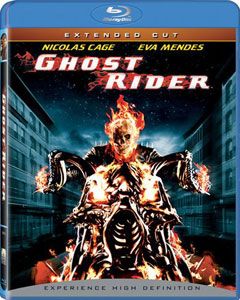Written and directed by Mark Steven Johnson, who also gave us “Daredevil” (2003), “Ghost Rider” (2007) is another slick Hollywood product from the era when seeing a comic-book superhero portrayed in live action had an intrinsic cool factor. But “Ghost Rider” is stridently paint-by-numbers, never off-the-rails incompetent in its production but never engaging in its narrative or themes. The best part about watching it is that I now have context for listening to the “Ghost Rider” episodes of podcasts that make fun of old movies.
Dots don’t connect
While it is paint-by-numbers, it’s not quite connect-the-dots. Or rather: We can see how the dots are supposed to connect, but we don’t feel like they are organically connecting. Motorcycle daredevil Johnny Blaze/Ghost Rider starts off as all-American-kid-faced Matt Long (“Jack and Bobby”), then becomes lived-in-faced Nicolas Cage, but also becomes a flaming-skull dude at night.
Suspension of disbelief would get me there except skull guy’s aims on that first night of transforming have nothing to do with Johnny’s life: Ghost Rider declares a street thug “guilty” – for attacking “Girl in Alley” Rebel Wilson — and kills him with his “penance stare.” (Sadly, Wilson’s two scenes, where she simply does her usual shtick, are the movie’s best.)

“Ghost Rider” (2007)
Director: Mark Steven Johnson
Writer: Mark Steven Johnson
Stars: Nicolas Cage, Eva Mendes, Sam Elliott
Is Johnny possessed? Or is Ghost Rider a deeper aspect of his psyche? Is Johnny a killer now? Or is it OK because that thug was evil, by definition of Ghost Rider’s superpower to accurately judge such things? “Ghost Rider” doesn’t particularly care – and viewers will have long since stopped caring about the film’s details by this point – because Johnson is merely adapting the Marvel comic in rote fashion.
But for the sake of overthinking it – rather than under-thinking it like the screenplay does – Ghost Rider in fiery skull form strikes me as a parallel to a werewolf: Johnny initially has no control over this nightly transformation or his actions while in this form.
On the other hand, Ghost Rider is going around judging people as “guilty” or “innocent,” so in “monster” form, he’s more engaged with societal issues than human-form Johnny is. This makes zero sense throughout most of “Ghost Rider.” At the end, when Johnny tells the Devil he chooses to keep his curse/gift, we finally understand that Johnny himself is interested in going around and judging people. Even then, we don’t really know why he’s drawn to this lifestyle.
Confusing motivations
I haven’t read the comic (launched in 1972 by a trio including Roy Thomas, who famously penned the “Star Wars” adaptation for Marvel), but I suspect it deserves better than this confusing sketch of the hero’s motivations combined with things we’ve seen elsewhere.
For example, Johnny’s girlfriend, Roxanne (Eva Mendes), will be used by the bad guys to get to Johnny. It’s not enough that this is a common trope; the film also spells it out twice, with both villain Blackheart (“American Beauty’s” Wes Bentley) and Ghost Rider’s ally, the Caretaker (Sam Elliott), announcing the trope.

Almost everyone in “Ghost Rider” is too good to be in “Ghost Rider,” although Elliott is so textbook Elliott here that no one else could play the role. (Close the voting, now: Elliott wins for Most Grizzled Human Ever.) Despite being the wise mentor, the Caretaker somehow says nothing wise, even in clichéd fashion, throughout the whole film. His opening and closing voiceovers about the truthfulness of legends are almost identical, an indication that the narrative and ideas didn’t progress.
As for Cage, this is the next best thing to playing Superman, which he at one point famously (or infamously) wanted to do. While Ghost Rider and Supes would seem to have little in common, both of their origin stories hit the secret identity beat, with Johnny’s romancing of Roxanne being hampered because he has to be Ghost Rider.
Needless to say, there’s a scene where he explains the situation and she thinks he’s a level of crazy that goes beyond motorcycle jumping; but mercifully, it’s not long after that that Roxanne sees he was telling the truth.
Pretty, but slick
Superficially, “Ghost Rider” is pretty to look at, as it creates “the West” (specifically Texas, I think) out of Melbourne and Vancouver. It looks too slick, though, and my brain told me this was all taking place in Australia. I feel like “Ghost Rider” needs to be grittier and genuinely dark, rather than merely taking place at night and featuring broad talk about devil’s bargains. The visual effects of Ghost Rider in his flaming skull form are quite good, albeit in service of nothing.
Maybe we see more grime and edge in “Ghost Rider: Spirit of Vengeance” (2011) and the MCU version of Ghost Rider (Gabriel Luna), who was introduced in “Agents of S.H.I.E.L.D.” and who will get his own show next year. But for now, I’m off to fire up those podcasts and have a few laughs.

